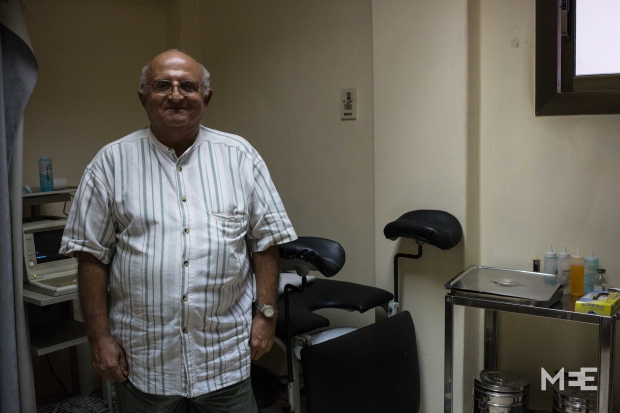Born by knife: In Egypt, C-sections are sold as the only way to give birth

As far as first pregnancies go, Nasraa felt she had been having a pretty good one. Her baby girl looked to be healthy and she herself felt strong, ready for delivery and motherhood. Every checkup had brought only good news - until her final, ninth-month visit. It was then that her doctor, cool and unconcerned, informed her that her pelvis was too narrow for a vaginal birth - so what date would she like to choose for her C-section?
“I didn’t know if he was lying or if he was telling the truth,” Nasraa said. “But he is the doctor and he is telling me I have to have a C-section. He closed the door. I didn’t have a choice.”
Nasraa, who comes from a village in Aswan in the farthest reaches of southern Egypt, had never questioned how she wanted to deliver. She wanted to give birth the way her mother had: by letting her body push the baby out. It was simple, it was natural and more than anything, it was cheap. A vaginal birth would cost her 800 Egyptian pounds ($100) at the Mahabba Hospital in Shubra - a C-section would cost about $500.
Nasraa is the second wife of a buffet cook - and she comes second financially too. She partially supports herself with a stipend she earns working as a bawwaba, or doorwoman, in a high-rise apartment building in downtown Cairo.
She chose the Mahabba Hospital because it was affordable, but not terrifying, like the public hospitals were. “A woman will do everything she can to avoid giving birth in a public hospital,” she said. Run through the charity of the Coptic Church, the Mahabba Hospital offered Nasraa a sterile, friendly environment at a discounted price. Still, at 4,000 Egyptian pounds, a C-section was the equivalent of almost four months of her and her husband’s combined salaries.
“Then there’s the recovery period,” Nasraa said. “With a natural birth, after three, four days, you’re fine, but with a C-section, you could wait one or two months and still not heal.” But in the end, what choice did she have? Her doctor told her she must give birth by cesarean, and so she did.
Today, 52 percent of women in Egypt give birth by C-section, according to the 2014 Demographic and Health Survey (DHS). That rate is 3.5 times higher than it should be, considering the World Health Organisation has set the target C-section rate at 15 percent. What’s more, the rate of C-sections has nearly doubled since the last DHS survey in 2008, when it was estimated to be around 27 percent. It’s only expected to continue rising in the years to come. Dr Sameh Sadek, director of the Alexandria Regional Medical Centre, called it an endemic problem.
“The C-section has become the most common procedure in private hospitals,” Sadek said. “And the private sector handles 60 percent of the deliveries, where there is little control over them.”
It’s not just a private sector problem however. In its 2008 survey, the DHS found that roughly a third of births in public hospitals were delivered by cesarean. There are many reasons why doctors everywhere are choosing to perform the surgery - but the well-being of their patient is rarely one of them, Sadek said.
Dr Wadia Labib, an obstetrician at the Mahabba Hospital, for instance, prefers to deliver by C-section because it’s less of a fuss. “It’s much more easy for the mother, for the doctor, for the baby,” Labib said. “The mother sleeps and gets up after half an hour with the baby beside her. The doctor takes 15 minutes instead of sitting with the patient half the day. It’s easy.”
Labib estimated that of the 2000 births that occurred at Mahabba every year, no less than 1600 were delivered by cesarean - and he saw no issue with this. “When I studied at Trinity [College in Dublin], they told us no more than 12 percent should be C-sections,” Labib said. “But that was 30 years ago. So many things have been changed. It is a very easy operation now.”
That’s exactly the sort of thinking that’s at the root of the problem, Sadek said. “A lot of women and physicians feel it’s safer even though the science shows this is not true,” Sadek said. Sadek serves on a national committee that monitors maternal mortality rates. When preparing his report on the Alexandria region for the most recent meeting, Sadek found that all the deaths that occurred during childbirth over the last six months had taken place during C-sections.
Risk of death
“You have four times increased chance of deaths during C-sections than vaginal births,” Sadek said.
Some physicians truly might not understand this, Sadek said, but plenty do and encourage their patients to have the operation anyway. In many cases, the women don’t need much convincing. “Women are also thinking that new technology is better, it’s progress,” Sadek said. As the surgery has become more and more common over the last decade, it’s also become more and more popular. In Labib’s experience, the only women who resist the idea of a cesarean are those who can’t afford it.
While the 2008 DHS data showed that the rate of C-sections increased with wealth, the 2014 data shows that the rate is becoming more similar across all income levels, governorates and education levels. Vaginal births are becoming a thing of the past. Increasingly, cesareans are seen as the way in which the modern woman gives birth - even if she must go deeply into debt to have one.
Nasraa is still $250 in debt from her second C-section over a year ago. While her husband’s health insurance paid for many of her medical expenses for her first delivery, they refused to cover her during her second pregnancy: only the first wife would be covered from here on out, they said, unless the husband would agree to pay a higher premium. (He didn’t).
Left in a lurch, Nasraa settled for a cheaper hospital and borrowed the money from her relatives to pay for her C-section. This time around, she didn’t even bother asking for a vaginal birth. Conventional wisdom in Egypt says a vaginal birth after a cesarean is impossible, although more and more medical professionals insist this is not the case. This is also one of the forces driving the rate of C-sections up: once a woman has a C-section, she is obliged to keep having them.
'All of my friends had one'
And when all a woman’s friends and relatives have C-sections, she comes to assume she will too. “I knew in Egypt, I would probably have to have one,” said Amal Raafat, an expecting mother from the wealthy Cairo suburb of 6th October. “All my friends have had one.”
Terrified by the prospect of being cut open - and, she admitted with a chuckle, the prospect of having a scar - Raafat began searching for a doctor who would be open to the option of a natural birth. After some Googling, she found herself in the office of Dr Iman Bastawisy, who runs a small private clinic in 6th October. Bastawisy in turn referred Raafat to a class on natural childbirth.
The class was the brainchild of Dr Hanaa Abu Kassem, director of obstetrics training at the Alexandria Regional Medical Centre and a pioneer in natural birth promotion. Since she grew aware of the problem of rising C-sections four years ago, Abu Kassem has become Egypt’s biggest crusader against the trend.
At her hospital in Alexandria, Abu Kassem runs a training course for doulas - birth assistants - who then go on to teach their own classes on natural childbirth for expectant mothers.
She designed the very course Raafat took and trained the woman who taught it. She also assists with deliveries in Alexandria hospitals, advocating for women who say they want a natural birth and challenging doctors who are hesitant to let them have one, in addition to running her own full-time antenatal clinic.
Childbirth is a business
Abu Kassem is also in the midst of planning the second Annual International Childbirth Conference, to be held 30 October to 2 November. She has recruited speakers from all over the world - even paying exorbitant speaking fees - in hopes of drawing in some of her fellow countrymen into her campaign.
As the conference draws nearer, the thought wears heavy on Abu Kassem’s mind that in the end, no one may show up. While her classes and training programmes have drawn the interest and praise of expatriate women, she has only trained one Egyptian doula to date. And while she’s been largely successful at changing the minds of expectant mothers, she’s yet to reach her fellow medical professionals. “I don’t know of anyone else doing this sort of work,” she said.
Abu Kassem faces an uphill battle to convince underpaid doctors to trade a quick, lucrative surgery for a drawn-out, unprofitable delivery. The Egyptian Ministry of Health shoulders much of the blame for allowing things to get this way, Sadek said. “The health system is complex and fragmented… and in the end, 70 percent of the health sector budget comes from the pockets of citizens,” Sadek said.
Or as Nasraa put it: “Childbirth has become a business.”
New MEE newsletter: Jerusalem Dispatch
Sign up to get the latest insights and analysis on Israel-Palestine, alongside Turkey Unpacked and other MEE newsletters
Middle East Eye delivers independent and unrivalled coverage and analysis of the Middle East, North Africa and beyond. To learn more about republishing this content and the associated fees, please fill out this form. More about MEE can be found here.





